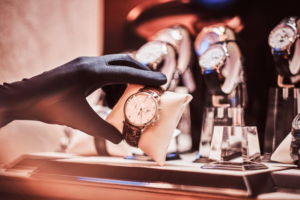Introduction
Luxury watches are a blend of craftsmanship, innovation, and aesthetic appeal. Each luxury timepiece, whether an elegant dress watch or a sporty chronograph, has a unique design that sets it apart from other timepieces in the market. For luxury brands, these designs are not just about aesthetics—they are valuable assets that represent their identity and craftsmanship. Therefore, protecting the uniqueness of these designs is critical, and Intellectual Property (IP) law, specifically the Designs Act, plays a crucial role in safeguarding these creations. In this blog, we will explore how IP law, focusing on the Designs Act, can protect the unique design of luxury watches.
The Role of Intellectual Property in Luxury Watch Design Protection
 IP law is essential for protecting the intangible assets of creators and businesses. In the context of luxury watches, these intangible assets are primarily the designs that make a timepiece unique. Luxury watchmakers invest significant resources in design, blending innovation with aesthetics to create masterpieces. These designs are what distinguish high-end watches from mass-produced timepieces.
IP law is essential for protecting the intangible assets of creators and businesses. In the context of luxury watches, these intangible assets are primarily the designs that make a timepiece unique. Luxury watchmakers invest significant resources in design, blending innovation with aesthetics to create masterpieces. These designs are what distinguish high-end watches from mass-produced timepieces.
The key forms of IP protection for watch designs include:
- Copyrights (for artistic works),
- Trademarks (for brand identity),
- Patents (for mechanical innovations),
- Designs (for the visual appearance of the product).
Of these, Design Rights under the Designs Act are especially relevant when it comes to protecting the unique visual design elements of a luxury watch.
Understanding the Designs Act
 The Designs Act, a significant piece of legislation in many jurisdictions, protects the aesthetic features of a product. A design is defined as the visual appearance of a product, including its shape, configuration, pattern, ornament, or composition of lines or colors. For luxury watches, this encompasses everything from the shape of the case and bezel to the layout of the dial, the design of the hands, and the bracelet or strap.
The Designs Act, a significant piece of legislation in many jurisdictions, protects the aesthetic features of a product. A design is defined as the visual appearance of a product, including its shape, configuration, pattern, ornament, or composition of lines or colors. For luxury watches, this encompasses everything from the shape of the case and bezel to the layout of the dial, the design of the hands, and the bracelet or strap.
In India, for instance, the Designs Act, of 2000, protects the new or original designs of industrial products. The Act allows designers to register their designs and grants them exclusive rights over their use for a set period (usually 10 years, extendable). This means that no one else can copy, replicate, or reproduce the registered design without the owner’s permission.
Protection Under the Designs Act for Luxury Watches
Luxury watchmakers are deeply concerned about the theft or imitation of their designs. A popular design in the market can quickly be copied, leading to market confusion and potential revenue loss. The Designs Act provides several layers of protection for luxury watchmakers.
 Registration of Design
Registration of Design
One of the primary protections under the Designs Act is the registration of a design. A luxury watch brand can register the unique visual design of their timepieces, which includes features like:
- The shape of the case (round, square, or unique form).
- The dial design (font style, pattern, and color).
- The strap design (material, shape, and pattern).
- The bezel and other ornamental aspects of the timepiece.
Once a design is registered, it is protected under law, and the designer or brand has the exclusive right to use it. Anyone who tries to copy or reproduce the design without authorization risks facing legal action, including penalties for infringement.
- Novelty and Originality
For a design to be protected under the Designs Act, it must be new and original. Luxury watch brands often go to great lengths to create unique, eye-catching designs that stand out in the marketplace. The novelty requirement ensures that no one can take inspiration from another existing watch design and make minor alterations. This is especially critical in the luxury sector, where even small changes to an iconic design can significantly affect the brand’s reputation.
- Scope of Protection
Once a design is registered, it is protected for a period of up to 10 years (in most jurisdictions). The designer has exclusive rights to use, license, or sell the design during this period. This exclusive right provides luxury watch brands with the ability to control how their designs are used and prevents unauthorized reproductions or imitations. It’s an essential tool to maintain brand exclusivity in a competitive market.
- Prevention of Infringement
The Designs Act helps in curbing the infringement of design by providing clear mechanisms for enforcement. If a counterfeit luxury watch brand attempts to launch a replica of a protected design, the original designer can take legal action against the infringer, which may include:
- Injunctions (stopping the infringing company from selling or producing the counterfeit).
- Damages (compensating for the loss in sales or reputation).
- Seizure of counterfeit goods (to prevent further circulation of fake products).
By enforcing design rights, luxury watch brands can protect their reputation and maintain the distinctiveness of their timepieces.
- International Protection
In the globalized world of luxury watches, international protection is vital. Many luxury watchmakers sell their products worldwide, and they need protection not only in their home country but also in other markets where their products are sold. Under the Hague System for the International Registration of Industrial Designs, brands can protect their watch designs in multiple countries by filing a single international application.
This system helps luxury watch brands secure their designs across different markets without having to register them individually in each country. It’s particularly useful for protecting high-end designs in global markets like the US, the EU, and Asia.
Conclusion
Luxury watches are not just timekeeping devices; they are symbols of craftsmanship, heritage, and exclusivity. Protecting the unique design of these timepieces is vital for luxury watch brands, and the Designs Act plays a central role in ensuring that brands retain control over their creations. By registering their designs, watchmakers can safeguard their innovative work from copycats and counterfeits, thereby maintaining their brand’s prestige and protecting their investment in design innovation. With the growing importance of global markets, it’s more important than ever for luxury watch brands to leverage IP law to preserve the distinctiveness of their iconic designs.





